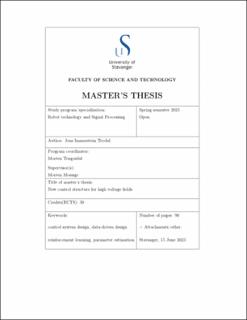| dc.contributor.advisor | Mossige, Morten | |
| dc.contributor.author | Trydal, Jens Immerstein | |
| dc.date.accessioned | 2023-09-16T15:51:25Z | |
| dc.date.available | 2023-09-16T15:51:25Z | |
| dc.date.issued | 2023 | |
| dc.identifier | no.uis:inspera:129730556:36591746 | |
| dc.identifier.uri | https://hdl.handle.net/11250/3089850 | |
| dc.description.abstract | In electrostatic painting, a high voltage is applied to the paint, attracting the paint particles toward a grounded work object, drastically increasing the efficiency of the painting process. However, combining high voltage and highly flammable paint is a potential hazard that is reduced by an automatic fire extinguishing system and strict controller limits defined by safety standards. The thesis investigates alternative controller strategies attempting to improve the performance of ABB's high-voltage control system.
The dynamics of electrostatic gas discharge, or corona discharge, is studied to estimate the relation between the applied voltage and the corona current passing through the electrostatic field. However, given the data available for the real-time system, the estimation problem is concluded to be structurally unidentifiable, resulting in the estimators not converging to the actual state of the system. Despite that, a simple estimator is utilized in a current limiting controller. This controller is activated when the system leaves its normal working area. Simulation results indicate that this controller can decrease the amount of unnecessary safety-related stops and reduce the reaction time for actual safety-hazard incidents.
Furthermore, a data-driven approach is selected to model and create a controller for the system generating the high-voltage output.
The model of the dynamics of the high-voltage system is created using neural networks and open-loop high-resolution data collected with a self-developed data acquisition program. Then, the estimated model is used in a reinforcement learning environment to create a theoretically optimal controller valid for the entire nonlinear workspace. Due to limited computational resources, and errors in the data, the thesis presents a lower-resolution proof of concept for both the neural network model and controller.
Additionally, the thesis presents a basis of knowledge on ABB's electrostatic painting system, featuring recommendations and suggestions for future work. | |
| dc.description.abstract | In electrostatic painting, a high voltage is applied to the paint, attracting the paint particles toward a grounded work object, drastically increasing the efficiency of the painting process. However, combining high voltage and highly flammable paint is a potential hazard that is reduced by an automatic fire extinguishing system and strict controller limits defined by safety standards. The thesis investigates alternative controller strategies attempting to improve the performance of ABB's high-voltage control system.
The dynamics of electrostatic gas discharge, or corona discharge, is studied to estimate the relation between the applied voltage and the corona current passing through the electrostatic field. However, given the data available for the real-time system, the estimation problem is concluded to be structurally unidentifiable, resulting in the estimators not converging to the actual state of the system. Despite that, a simple estimator is utilized in a current limiting controller. This controller is activated when the system leaves its normal working area. Simulation results indicate that this controller can decrease the amount of unnecessary safety-related stops and reduce the reaction time for actual safety-hazard incidents.
Furthermore, a data-driven approach is selected to model and create a controller for the system generating the high-voltage output.
The model of the dynamics of the high-voltage system is created using neural networks and open-loop high-resolution data collected with a self-developed data acquisition program. Then, the estimated model is used in a reinforcement learning environment to create a theoretically optimal controller valid for the entire nonlinear workspace. Due to limited computational resources, and errors in the data, the thesis presents a lower-resolution proof of concept for both the neural network model and controller.
Additionally, the thesis presents a basis of knowledge on ABB's electrostatic painting system, featuring recommendations and suggestions for future work. | |
| dc.language | eng | |
| dc.publisher | uis | |
| dc.title | New control structure for high voltage fields | |
| dc.type | Master thesis | |
